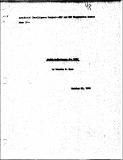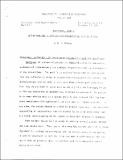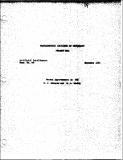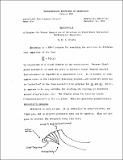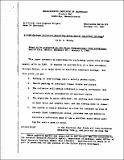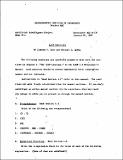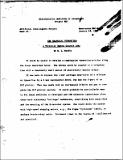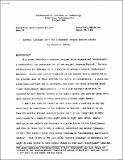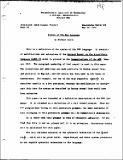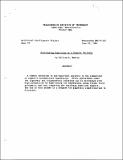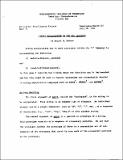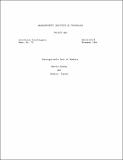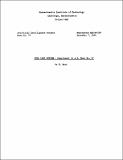Browsing AI Memos (1959 - 2004) by Issue Date
Now showing items 21-40 of 1217
-
A Proposal for a Geometry Theorem Proving Program
(1963-09-01)During the last half of the nineteenth century the need for formal methods of proof became evident to mathematicians who were making such confidence-shaking discoveries as non-Euclidean geometry. The demand is not to be ... -
MACRO Definitions for LISP
(1963-10-01)In LISP 1.5 special forms are used for three logically separate purposes: a) to reach the alist, b) to allow functions to have an indefinite number of arguments, and c) to keep arguments from being evaluated. New LISP ... -
MATHSCOPE Part I: A Proposal for a Mathematical Manipulation-Display System
(1963-11-01)Mathscope: A compiler for two-dimensional mathematical picture syntax. Mathscope is a proposed program for displaying publication-quality mathematical expressions given symbolic (list-structure) representations of the ... -
Recent Improvements in DDT
(1963-11-01)This paper will report new developments and recent improvements to DDT. "Window DDT" now will remember undefined symbols and define them on a later command. Using sequence breaks, it can change the contents of memory while ... -
Operation of a Semantic Question-Answering System
(1963-11-01)A computer program has been written in the LISP programming language which accepts information and answers questions presented to it in a restricted form of natural English language. The program achieves its effects by ... -
Secondary Storage in LISP
(1963-12-01)A principal limitation of LISP processors in many computations is that of inadequate primary random-access storage. This paper explores several methods of using a secondary storage medum (such as drums, disk files or magetic ... -
DERIVATOR I: A Program for Visual Inspection of Solutions to First-Order Non-Linear Differential Equations
(1963-12-01)Derivator is a PDP-1 program for examining the solutions to differential equations by inspection of a visual display of trajectories. Because fixed-point arithmetic is used (in order to maintain visual display speeds), ... -
A LISP Garbage Collector Algorithm Using Serial Secondary Storage
(1963-12-27)This paper presents an algorithm for reclaiming unused free storage memory cells in LISP. It depends on availability of a fast secondary storage device, or a large block of available temporary storage. For this price, we ... -
LISP Exercises
(1964-01-01)The following exercises are carefully graded to mesh with the sections in Chapter I, "The LISP Language", in the LISP 1.5 Programmer's Manual. Each exercise should be worked immediately after reading the manual section indicated. -
The Graphical Typewriter: A Versatile Remote Console Idea
(1964-01-01)It would be useful to develop a combination typewriter-plotter along the lines described below. The device could be coupled to a telephone line with a reasonably small amount of electronics -- mostly relays. -
Natural Language Input for a Computer Problem Solving System
(1964-03-01)This paper describes a computer program which accepts and "understands" a comfortable, but restricted set of one natural language, English. Certain difficulties are inherent in this problem of making a machine "understand" ... -
REVISED USER'S VERSION - Time Sharing LISP
(1964-04-01)This memo describes changes to the LISP system by several people. The changes reduce printout and give the user more control over it. They also make it possible for LISP to communicate with the teletype and the disk. The ... -
New Language Storage Conventions
(1964-05-01)These conventions are for the implementation of the new language on a large computer on which time-sharing is the standard role of operation. Each user is at any time asigned a certain amount of primary storage. This ... -
Syntax of the New Language
(1964-05-01)This is a definition of the syntax of the *** language. It consists of modifications and extensions of the "Revised Report on the Algorithmic Language ALGOL 60" which is printed in the "Communications of the ACM", January ... -
Hash-Coding Functions of a Complex Variable
(1964-06-25)A common operation in non-numerical analysis is the comparison of symbolic mathematical expressions. Often equivalence under the algebraic and trigonometric relations can be determined with the high probability by hash-coding ... -
String Manipulation in the New Language
(1964-07-01)String manipulation can be made convenient within the *** language by implementing two functions: 1) match [workspace; pattern] and 2) construct {format;pmatch]. In this memo I describe how I think these two functions can ... -
Proposed Instructions on the GE 635 for List Processing and Push Down Stacks
(1964-09-01)The instructions that transmit data between the index registers and the memory work only on the left half (address) portion of memory. These instructions are LDXn (load index n from address of storage word). And STXn (store ... -
Unrecognizable Sets of Numbers
(1964-11-01)When is a set A of positive integers, represented as binary numbers, "regular" in the sense that it is a set of sequences that can be recognized by a finite-state machine? Let pie A(n) be the number of members of A less ... -
CTSS LISP Notice-Supplement to A.I. Memo No. 67
(1964-12-01)The LISP system (command version) has been updated. Bugs are corrected include: 1. out of pushdown list in compiled function will not transfer to 77777. 2. with compiler printing turned off by comprint, it is truly off. ... -
Television Camera-To-Computer Adapter: PDP-6 Device 770
(1965-01-01)The TVA (Television Adaptor) is a data-input device just completed. Any standard Closed-Circuit Television Camera can be connected to the PDP-6, without modification, by a single BNC connector. Then a simple program can ...

